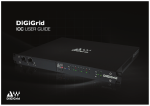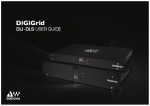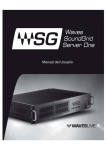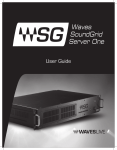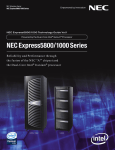Download ALLEN & HEATH iLIVE User guide
Transcript
M-WAVES AUDIO INTERFACE 1 1 ALLEN & HEATH M-WAVES CARD USER GUIDE M-WAVES AUDIO INTERFACE Table of Contents Introduction3 1. Hardware and Connectors 7 2. Installation and Configuration Overview 8 2.1 Installing the M-Waves Card 8 2.2 Configuring the M-Waves in MultiRack SoundGrid 9 2.3 Configuring the M-Waves in SoundGrid Studio 10 2.3.1 Setting Up SoundGrid Studio 10 2.3.2 Firmware Status and Updates 14 3. M-Waves Control Panel (V2 only) 15 3.1 Clock Page 15 3.2 About Page 16 3.3 System Info Page 17 3.4 Saving, Loading and Identifying 17 4. Working with Two M-Waves Cards 18 M-WAVES AUDIO INTERFACE INTRODUCTION Thank you for choosing an Allen & Heath M-Waves Card for SoundGrid systems. In order to get the most out of your M-Waves product, please take some time to read this user guide. We also suggest that you become familiar with the Waves support site (www.wavesupport.net), where you will find an extensive answer base, the latest tech specs, detailed installation guides, software updates, and current information about licensing and registration. About SoundGrid and the Allen & Heath M-Waves Card SoundGrid is a scalable infrastructure that provides a variety of cost-effective, high-quality solutions for recording studios. It can be configured in many ways and with many hardware possibilities to provide a very flexible work environment. This framework is managed by the SoundGrid Studio Application, which configures the network, assigns and manages I/Os, controllers and servers, and patches audio throughout the system. Any user, anywhere on the SoundGrid network, has access to any of the network’s I/O devices. Adding a SoundGrid DSP server enables recording and monitoring with very low latency and moves processing away from the host computer to the server. The M-Waves card for Allen & Heath iLIVE and GLD consoles enables integration with Waves SoundGrid systems via a single Ethernet cable, allowing live sound engineers to use the SoundGrid networking technology for low-latency plugin processing, multitrack recording and playback, and audio networking. M-Waves V2 also features Clock Sync-over-Ethernet for syncing multiple consoles and performing digital splits. ■ ■ ■ ■ ■ ■ 3 S uper-low-latency networking platform for processing, playback and recording E ach M-Waves card allows 64 channels of bi-directional audio C onnects via a single Cat5e or Cat6 Ethernet cable Clock Sync-over-Ethernet for digital splits (M-Waves V2) Connects to SoundGrid systems and SoundGrid-compatible devices via a single Ethernet cable Compatible with standard computers and switches M-WAVES AUDIO INTERFACE ■ ■ ■ ■ ■ edundancy and recovery options R Built-in 3-port Gigabit switch for direct connection to multiple devices ASIO/Core Audio drivers for recording and playback Works with MultiRack SoundGrid software for setup and control Networks with consoles installed with M-Waves V1 Typical Uses The M-Waves card can be used in both SoundGrid and Native configurations, as follows: SoundGrid: In a SoundGrid configuration, the M-Waves card is used in order to connect to a SoundGrid network for plugin processing and simultaneous DAW playback/recording. The SoundGrid configuration uses a dedicated SoundGrid DSP server to power the plugin processing, enabling super-low latency, high plugin counts, and networking capabilities, with the option of an additional backup DSP server. Please note: A SoundGrid DSP server is required for SoundGrid processing. M-WAVES I/O Card MultiRack SG Allen & Heath digital Console StageBox Server DAW / SG Studio 4 M-WAVES AUDIO INTERFACE Native: In a Native configuration, the M-Waves card is used in order to connect a console to the SoundGrid ASIO/Core Audio driver for plugin processing and/or DAW playback/recording. Since the Native configuration utilizes the computer’s CPU to power the plugin processing, plugin count and overall system latency depend on the computer’s CPU and sound driver capabilities. Please note: A SoundGrid DSP server is not required for Native processing. M-WAVES I/O Card Allen & Heath Console StageBox MR Native/DAW/SG Studio 5 M-WAVES AUDIO INTERFACE 6 Native/SoundGrid Comparison Table Features Native SoundGrid ■ Low Latency Processing ■ ■ Recording ■ ■ ■ Simultaneous Recording and Processing CPU Load Your DAW computer's CPU Dedicated SoundGrid DSP server Backup DSP Server ■ Networking ■ I/O M-Waves M-Waves Plugin Host Software MultiRack Native MultiRack SoundGrid Plugin Licenses Native SoundGrid M-WAVES AUDIO INTERFACE 1. HARDWARE AND CONNECTORS Network Ports Network Activity Led Gigabyte Connection Indicator SoundGrid Ports 1-3 (Ethernet) connect the SoundGrid Network. Status LED: SoundGrid Ports 2 and 3 have a network activity led only. Only SoundGrid Port 1 has a Gigabyte connection indicator. Colors and respective status are as follows: SoundGrid Ports 2 and 3: ■ Link/Act Led = flashing amber SoundGrid Port 1: ■ Link/Act Led = flashing green ■ GigE (Gigabyte Connection Indicator) = solid green 7 M-WAVES AUDIO INTERFACE 2. INSTALLATION AND CONFIGURATION OVERVIEW The ASIO/Core Audio drivers and control panel for the Allen & Heath M-Waves are installed using the Allen & Heath M-Waves installer, which also installs the SoundGrid driver and the SoundGrid Studio Application required for DAW recording and playback. Allen & Heath M-Waves downloads page: http://www.waves.com/downloads/allen-heath 2.1 Installing the M-Waves Card 1. Turn your console OFF. 2. In the back of your console, unscrew the protective cover from the Port B slot to which you will be installing. 3. Slide in the card carefully, until you feel it dock into place. 4. Make sure the card is seated firmly; screw it in for added protection. 5. Turn your console back on. For further instructions, please refer to your Allen & Heath manual for the M-Waves card. 8 M-WAVES AUDIO INTERFACE 2.2 Configuring the M-Waves in MultiRack SoundGrid Access the M-Waves control panel via the Inventory window in the MultiRack SoundGrid application. 1. Launch the MultiRack SoundGrid application. 2. Enter the Preferences window by typing Ctrl+P (Windows) or Cmd+ (Mac), or from the appropriate application menus. 3. Under Local LAN Port, choose the adapter connected to the SoundGrid network and the M-Waves card. Network adapters are displayed as MAC addresses and port names. 4. When you select the correct port, the message “SoundGrid Network Found” will appear on the panel. Close this window. 5. Open the SoundGrid Inventory window from the Audio Menu (F2). The SoundGrid Inventory window displays all SoundGrid I/O devices connected to your network. 6. Assign SoundGrid drivers in the Assign column. Use consecutive numbers for multiple devices, with the first unit assigned as number 1. 7. Assign SoundGrid DSP servers in the Assign column. The primary SoundGrid DSP server will be assigned as number 1. If you are using a redundant SoundGrid DSP server, assign it as number 2. 8. Assign your M-Waves card/s in the Assign column. Use consecutive numbers for multiple devices, with the first unit assigned as number 1. 9. Click Settings to open the M-Waves Control Panel window. 9 M-WAVES AUDIO INTERFACE 2.3 Configuring the M-Waves in SoundGrid Studio This is a quick overview of what you need to know about SoundGrid Studio software to get your network up to speed. There’s enough here to configure a simple network, assess network status, and set up your I/O devices. For more complex configurations, please refer to the SoundGrid and SoundGrid Studio user guides. 2.3.1 Setting Up SoundGrid Studio The SoundGrid Studio Application oversees the SoundGrid network and manages all network devices. To maintain network effectiveness, the SoundGrid Studio Application is always running in the background. Bring SoundGrid Studio to the front by clicking on the SoundGrid icon in the Mac Top Bar or the Windows System Tray. PC 10 Mac M-WAVES AUDIO INTERFACE When SoundGrid Studio opens you will see the System Inventory page. The first time you launch SoundGrid Studio, the Wizard will open. This is a tool that scans the network, inventories its assets, and then configures the relevant devices. If the Wizard does not start automatically, click the SCAN button, which is located next to the Network Port window. Once it scans the system, the Wizard will offer to configure the SoundGrid network. Choose NEXT to start automatic configuration. This will take a few moments. Choose CANCEL to configure manually. A drop-down menu will provide a list of configuration templates. Choose the template that best describes your devices and production needs. You can also save and load your own templates. 11 M-WAVES AUDIO INTERFACE If the Wizard cannot locate the requested SoundGrid network devices, this means you may have chosen an incorrect network port on your computer. Check the physical connections and then click SCAN. When configuration is complete, close the window. If there is still a problem, you can configure your system manually. Use the System Inventory page to assign devices, control the network, and manage clock. To learn how to use this page, please refer to the user guides for SoundGrid Studio and StudioRack. The first device added to a rack is designated as the Sync-over-Ethernet clock master and is placed in the first rack slot. A populated device slot displays the mode, clock status, and sample rate of the I/O. The clock master device is indicated by its blue color and the icon text: On, Master Clock, INT (48 kHz). 12 M-WAVES AUDIO INTERFACE 13 To add another SoundGrid device, click on the arrow in an empty rack slot. From the list of available devices, choose the one that you want to add—in this case, a second M-Waves card. In this image, M-Waves V2-1 is grayed out (and therefore unavailable) since it is already claimed. The new device is visible in the rack slot. Unless changed by the user, it remains the clock slave and is colored green. Use the same menu to change the assignment of clock master from one device to another, or to remove the device from the rack slot. Now you know how to assign I/O devices and designate a device as the clock master. Click on the Gear symbol in the device slot to open the M-Waves Control Panel in order to set up clock details and configure preamps. M-WAVES AUDIO INTERFACE 2.3.2 Firmware Status and Updates On the left of the device icon are two buttons: FW indicates the status of the device’s firmware. The user is given the choice to update it. Status indications are color-coded: Grey Compatible firmware Blue Compatible firmware, but a newer version exists Red Firmware not compatible and must be updated in order to use Click on the FW button to launch the Reflasher. This will initiate a scan of the hardware and then offer options. Do not disconnect device or turn off computer until you see “Done.” ID activates LEDs on the front panel of the hardware device. 14 M-WAVES AUDIO INTERFACE 3. M-WAVES CONTROL PANEL (V2 ONLY) If you are working with MultiRack SoundGrid, access the M-Waves V2 Control Panel via the Inventory window. If you are using SoundGrid Studio, click on the Gear symbol in the device slot to open the M-Waves V2 Control Panel. 3.1 Clock Page When you launch the M-Waves V2 control panel, it will load the Clock tab. The following settings are available in the Clock Settings window. SOURCE sets the clock source. Internal The unit itself provides the clock. Digital Syncs via the M-Waves V2 connection to the console. Sync-overEthernet Send or receive Word Clock / Sample Rate over the Ethernet cable between M-Waves and other SoundGrid devices. SAMPLE RATE sets the sample rate when Clock Source is set to Internal. 15 M-WAVES AUDIO INTERFACE 16 STATUS displays synchronization status (Sync or No Sync). CURRENT CLOCK SOURCE IS displays the current sync method. SOE displays Sync-over-Ethernet status (On or Off ). LOAD and SAVE (at the top left corner of the control panel window) allow you to save and load your M-Waves V2 settings. 3.2 About Page The About page displays an overview of the device’s specifications. M-WAVES AUDIO INTERFACE 3.3 System Info Page The System Info page displays the device’s connection status, manufacturer, model, MAC and SoE Master MAC addresses, and firmware version. 3.4 Saving, Loading and Identifying LOAD and SAVE (at the top left corner of the Control Panel window) allow you to save and load your M-Waves settings. IDENTIFY (at the top right corner of the Control Panel window) allows you to identify connected devices if multiple M-Waves s are being used. The Status LED will become solid instead of flashing. 17 M-WAVES AUDIO INTERFACE 4. WORKING WITH TWO M-WAVES CARDS You can use M-Waves V1 and V2 Cards in the same setup. The only limitation is that a first-generation M-Waves card, an M-Waves V1, cannot be an Ethernet clock (SoE) slave. It must provide clock sync to a second-generation card, an M-waves V2. Setting up the clock master for the network is done in either MultiRack SoundGrid or SoundGrid Studio applications. In the Waves SoundGrid Inventory window, assign the two M-Waves cards to 1 and 2 consecutively. Select the one you want to be the master under the Master column. To synchronize the two M-Waves cards, choose one of the following two options: 1. If you want the iLive system to be the source (Internal): (a) On the iLive system, set Audio Clock Source to Internal. (b) In the SoundGrid Inventory window, click on the Settings for the M-Waves V2 card assigned to 1, and set it to Digital. (c) Click on the Settings for the M-Waves V2 card assigned to 2. It will be set automatically as Slave and the source will automatically be synced over Ethernet. 18 M-WAVES AUDIO INTERFACE 2. If you want the iLive system to get its source from Port B: (a) On the iLive system, set Audio Clock Source to Port B. (b) On the SoundGrid Inventory window, click on the Settings for the M-Waves V2 card assigned to 1, and set it to Internal. (c) Click on the Settings for the M-Waves V2 card assigned to 2. It will be set automatically as Slave and the source will automatically be synced over Ethernet. 19























